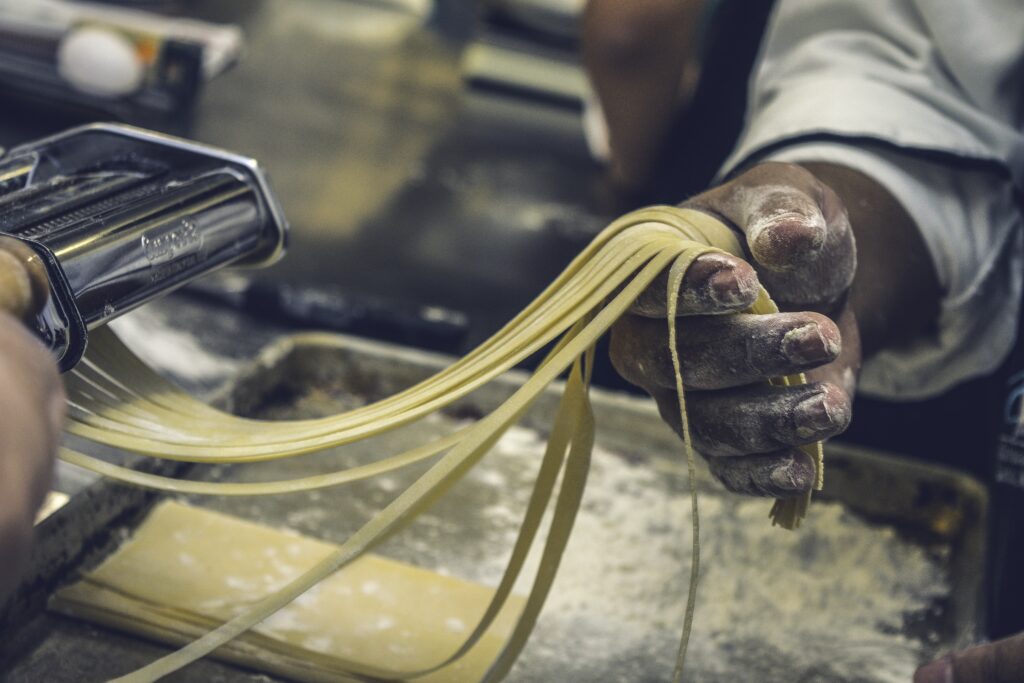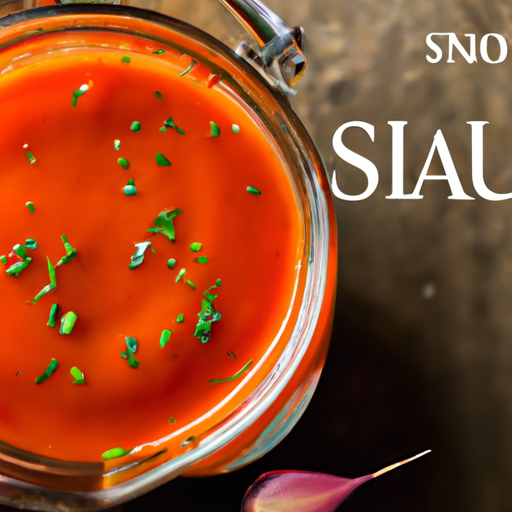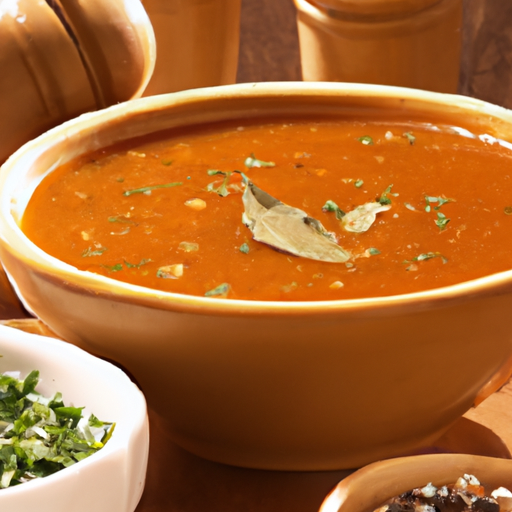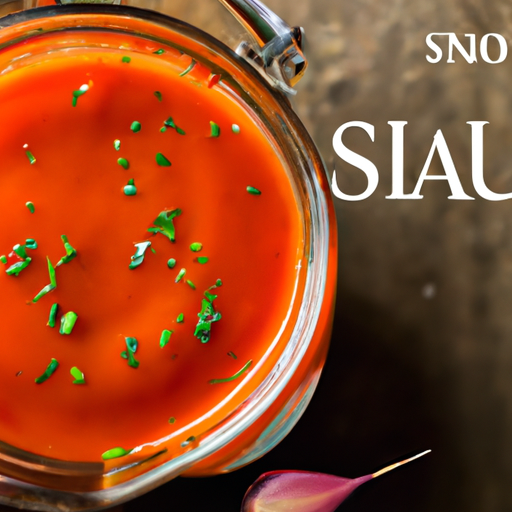Creating a flavorful and well-balanced sauce from scratch may seem like a daunting task, but with a few basic steps, you’ll be able to achieve incredible results in no time. In this article, we’ll explore the art of sauce making, focusing on essential cooking skills and techniques that will help you elevate your culinary creations. Whether you’re a beginner or a seasoned chef, these tips and tricks will guide you in crafting the perfect sauce to complement any dish. Get ready to impress your taste buds and elevate your cooking game to new heights!
Choosing the Right Ingredients
Choosing the right ingredients is essential when creating a flavorful and well-balanced sauce from scratch. Every ingredient contributes to the overall taste and texture of the sauce, so it’s important to select high-quality ingredients that will enhance the final result.
Selecting Fresh Herbs and Spices
Fresh herbs and spices are the backbone of a delicious sauce. They add depth, aroma, and unique flavors to your dish. When selecting herbs, look for vibrant colors and intact leaves. Avoid any wilting or discoloration. For spices, choose whole seeds or pods whenever possible, as they have a longer shelf life and retain their flavor better.
Using High-Quality Fats and Oils
Fats and oils play a crucial role in sauce making, providing richness and mouthfeel. Opt for high-quality fats like butter, olive oil, or coconut oil. These fats will add a rich flavor and smooth texture to your sauce. Avoid using low-quality oils or hydrogenated fats as they can overpower the taste and compromise the overall quality of the sauce.
Considering Sweet and Tangy Elements
To achieve a well-balanced sauce, it’s important to incorporate sweet and tangy elements. Sweet ingredients like honey, maple syrup, or brown sugar can help round out the flavors and add complexity. Tangy ingredients, such as vinegar or citrus juice, provide acidity and brightness. Experiment with different combinations to find the perfect balance for your sauce.
Using Fresh Vegetables or Homemade Stocks
Fresh vegetables and homemade stocks can elevate the flavor of your sauce to new heights. Opt for fresh, seasonal vegetables whenever possible, as they tend to have a more vibrant taste. If time allows, prepare your own stock by simmering meat, bones, or vegetables. Homemade stocks add depth and richness that store-bought versions often lack.
Preparing the Ingredients
Before you start cooking, it’s crucial to prepare your ingredients properly. Proper preparation ensures that the flavors are fully extracted and distributed throughout the sauce.
Washing and Chopping the Herbs
Fresh herbs need to be washed and chopped before using them in your sauce. Rinse the herbs under cold water to remove any dirt or debris. Gently pat them dry with a paper towel, then remove the leaves from the stems. Chop the leaves finely to release their flavors fully.
Mincing Garlic and Ginger
Garlic and ginger are often used as aromatics in sauces, adding a powerful flavor punch. To prepare garlic, peel the cloves and mince them finely. For ginger, peel the skin using a spoon or a peeler, then grate it or mince it into small pieces. These aromatic ingredients should be finely chopped to distribute their flavors evenly throughout the sauce.
Grating or Zesting Citrus Fruits
If your sauce calls for citrus flavor, grating or zesting citrus fruits is the way to go. Use a fine grater or a zester to remove the colorful outer layer of the fruit’s skin. Be careful not to include the bitter white pith underneath. The zest adds a burst of citrus flavor to your sauce without adding too much acidity.
Measuring and Preparing Liquids
When it comes to liquids, accuracy is key. Measure the liquids required for your sauce using measuring cups or a kitchen scale. Consistency is crucial for a well-balanced sauce. If your recipe calls for a certain temperature, such as warm milk, be sure to heat it to the specified temperature. This ensures that the liquids properly incorporate into the sauce.

Building Flavors through Cooking Techniques
Building flavors is an essential step in creating a flavorful and well-balanced sauce. Different cooking techniques allow the ingredients to develop their flavors fully and create a harmonious taste.
Sautéing Aromatics
Sautéing aromatics like onions, garlic, and shallots in oil or butter is a common technique in many sauce recipes. This process helps to release their natural flavors and adds depth to the sauce. Heat the oil or butter in a pan, add the aromatics, and cook them over medium heat until they become fragrant and translucent.
Blooming Spices in Hot Fat
Blooming spices in hot fat is a technique that helps to intensify their flavors. This step is particularly important for dried spices, like cumin, coriander, or paprika. Heat a small amount of oil or butter in a pan and add the spices. Cook them for a minute or two until they become fragrant, being careful not to burn them.
Creating a Roux or Slurry
To add thickness and richness to your sauce, consider creating a roux or slurry. A roux is a mixture of equal parts flour and fat (butter or oil) cooked together before adding liquid. A slurry, on the other hand, is a mixture of flour or cornstarch and cold liquid, like water or broth. Both techniques help to thicken the sauce and add body.
Caramelizing Onions or Sugar
Caramelizing onions or sugar can add a sweet and savory depth to your sauce. Slowly cooking onions over low heat until they turn golden brown releases their natural sugars and creates a rich flavor. When using sugar, it’s important to melt it slowly, stirring constantly, until it becomes a dark amber color. The caramelized onions or sugar can elevate the taste of your sauce.
Balancing the Sauce with Flavors
Balancing the flavors in your sauce is crucial for creating a well-balanced dish. Adding the right amount of sweet, salty, acidic, and spicy elements will ensure that no flavor dominates and that all the flavors harmonize perfectly.
Adding Acidic Components
Acidic components like vinegar, citrus juice, or wine can brighten up the flavors in your sauce. They help to balance the richness and add a tangy note to the dish. Start by adding a small amount, then taste and adjust as needed to achieve the desired level of acidity.
Incorporating Salty and Umami Elements
Salt and umami are essential to balance the flavors in your sauce. Salt enhances the existing flavors, while umami adds a savory, meaty depth. Use salt sparingly and add it gradually, tasting along the way. For umami, ingredients like soy sauce, Worcestershire sauce, or fish sauce can be added to enhance the depth of flavor.
Adjusting Sweetness and Bitterness
Sweetness and bitterness can also contribute to the balance of flavors in your sauce. To add sweetness, consider using ingredients like honey, maple syrup, or brown sugar. Bitterness can be added with ingredients like dark chocolate, coffee, or bitter greens like kale or arugula. Both elements should be adjusted carefully to avoid overpowering the other flavors.
Enhancing with Heat or Spice
Heat or spice can add an extra layer of flavor to your sauce. Depending on the level of spiciness desired, you can add chili peppers, hot sauce, or red pepper flakes. Start with a small amount and gradually increase until you achieve the desired level of heat. Be mindful of the other flavors and the overall balance of the sauce.

Thickening and Binding the Sauce
Thickening and binding a sauce can make it more luscious and cohesive. There are several techniques that can be used to achieve the desired consistency.
Reducing the Liquid
One simple way to thicken a sauce is to reduce the liquid by simmering it over low heat. This allows the liquid to evaporate, resulting in a thicker sauce. Keep in mind that reducing the liquid can also intensify the flavors, so adjust the seasoning accordingly.
Creating a Slurry or Cornstarch Mixture
Creating a slurry is another effective way to thicken a sauce. Mix equal parts cornstarch and cold liquid, such as water or broth, until smooth. Gradually pour the slurry into the sauce while stirring continuously. Cook the sauce for a few minutes to allow the cornstarch to activate and thicken the sauce.
Using Roux to Thicken
As mentioned earlier, a roux can be used to thicken a sauce. Cook equal parts flour and fat (butter or oil) together until it forms a smooth paste. Gradually whisk in liquid, such as milk or broth, and continue cooking until the sauce reaches the desired thickness. The roux adds a velvety texture to the sauce.
Using Natural Thickeners like Pureed Vegetables or Beans
For a healthier alternative, consider using natural thickeners like pureed vegetables or beans. These ingredients not only add thickness but also contribute to the overall flavor profile. Puree cooked vegetables or beans until smooth, then add them to the sauce, stirring until incorporated. Be mindful of the additional flavors introduced by the vegetables or beans.
Simmering and Reducing the Sauce
Simmering and reducing the sauce allows the flavors to meld together and develop fully. It’s a crucial step in sauce making to achieve a well-balanced and flavorful result.
Applying Proper Heat and Time
Simmer the sauce over low to medium-low heat to ensure gentle cooking. This allows the flavors to slowly develop and meld together. Avoid boiling the sauce, as it can cause the flavors to become overpowering or unevenly distributed. The cooking time will vary depending on the recipe, so follow the instructions closely.
Monitoring the Consistency
During the simmering process, it’s important to monitor the consistency of the sauce. Stir the sauce occasionally and pay attention to its thickness. If it’s becoming too thick, you can add a small amount of liquid to loosen it. Conversely, if it’s too thin, continue simmering until it reaches the desired consistency.
Allowing Flavors to Develop
While simmering, allow the flavors to develop by giving the sauce enough time to cook. This step is essential for unlocking the full potential of the ingredients and achieving a well-rounded taste. Be patient and resist the temptation to rush through this process. The longer the sauce simmers, the more the flavors will intensify and harmonize.
Adjusting Seasonings and Thickness
Throughout the simmering process, taste the sauce occasionally and adjust the seasonings if necessary. If the flavors need a boost, add a pinch of salt, a squeeze of lemon juice, or a dash of Worcestershire sauce. If the sauce is too thin or lacking body, refer back to the thickening techniques and adjust accordingly.

Straining and Blending the Sauce
Straining and blending the sauce can help achieve a smooth and refined texture. This step is particularly important when working with sauces that contain whole spices, herbs, or large chunks of ingredients.
Removing Whole Spices and Herbs
To eliminate any whole spices or herbs, strain the sauce using a fine-mesh sieve or cheesecloth. This will ensure that the sauce is free from any unwanted solids. Straining also helps to create a smoother texture, especially if you prefer a velvety consistency.
Straining Out Unwanted Solids
If your sauce contains other unwanted solids, such as seeds, skins, or large pieces of cooked vegetables, strain it through a fine-mesh sieve or use a blender to achieve a smooth texture. This will help refine the sauce and remove any undesirable elements.
Using Immersion Blender or Food Processor
If you prefer a creamier texture, consider using an immersion blender or food processor to puree the sauce. This will break down any remaining fibrous elements and create a more homogenous sauce. Be cautious when working with hot liquids and follow the manufacturer’s instructions for blending.
Achieving Desired Texture and Smoothness
The final goal when straining and blending the sauce is to achieve the desired texture and smoothness. The level of refinement depends on personal preference and the specific recipe. Experiment with different techniques to find the perfect balance between texture and flavor.
Adjusting and Enhancing the Flavor
Adjusting and enhancing the flavor of your sauce is the final step in creating a well-balanced masterpiece. Fine-tuning the seasonings and adding finishing ingredients can take your sauce to the next level.
Tasting and Adjusting Seasonings
Before serving, it’s crucial to taste your sauce to ensure it has the perfect balance. Adjust the seasonings as needed, adding more salt, pepper, spices, or herbs. Remember that seasoning should be done gradually, tasting as you go, to avoid over-seasoning.
Balancing Saltiness, Sweetness, and Acidity
Pay close attention to the balance of saltiness, sweetness, and acidity in your sauce. These elements play a vital role in achieving a well-balanced flavor profile. Experiment with small increments of salt, sugar, or acid, such as lemon juice or vinegar, until the flavors are harmonious.
Adding Fresh Herbs or Additional Spices
To enhance the flavor and add freshness to your sauce, consider incorporating fresh herbs or additional spices. Finely chop fresh herbs like basil, cilantro, or parsley and sprinkle them on top of your finished sauce. This will provide a burst of brightness and elevate the overall taste.
Using Finishing Ingredients like Butter or Cream
Butter or cream can be used as finishing ingredients to add richness and depth to your sauce. Stir in a small amount of butter or cream towards the end of the cooking process, allowing it to melt and incorporate into the sauce. This will create a luscious, velvety texture and enhance the flavors even further.

Storing and Preserving the Sauce
After all the hard work of creating a flavorful and well-balanced sauce, it’s important to store and preserve it properly to maintain its quality and longevity.
Cooling and Transferring to Proper Containers
Allow your sauce to cool completely before transferring it to storage containers. This ensures that the sauce sets properly and minimizes the risk of moisture buildup that could lead to spoilage. Use airtight containers made of glass or high-quality plastic to maintain freshness.
Refrigerating or Freezing for Longevity
Refrigerating or freezing your sauce is the best way to extend its shelf life. If you plan to use the sauce within a few days, store it in the refrigerator. For longer-term storage, transfer the sauce to freezer-safe containers and place them in the freezer. Be sure to label the containers with the date to keep track of freshness.
Sealing and Labeling for Easy Identification
To ensure the sauce stays fresh and avoids contamination, seal the storage containers tightly. Use plastic wrap, aluminum foil, or lids that fit securely. Additionally, label the containers with the name of the sauce and the date it was prepared. This makes it easier to identify and use the sauce at a later time.
Ensuring Proper Food Safety Measures
Food safety is essential when storing and preserving sauces. Always practice proper hygiene, such as washing your hands before handling the sauce or containers. Be mindful of expiration dates and discard any sauce that shows signs of spoilage, such as mold or an off odor.
Experimenting and Customizing Sauce Recipes
Once you have mastered the basic steps of creating a flavorful and well-balanced sauce, it’s time to unleash your creativity and experiment with different flavors and ingredients.
Adding Personal Touches and Variations
Make the sauce your own by adding personal touches and variations. Experiment with different combinations of herbs, spices, and seasonings to suit your taste preferences. Consider adding a splash of your favorite alcohol for a unique twist or incorporating ingredients that represent your culinary heritage.
Combining Different Cuisines and Ingredients
Don’t be afraid to combine different cuisines and ingredients to create fusion sauces. Blend the flavors of traditional dishes from different cultures to create a unique and exciting taste experience. Mix and match ingredients from various cuisines, such as Italian, Mexican, or Asian, to create harmonious flavors.
Balancing Traditional and Modern Flavors
Strive to strike a balance between traditional and modern flavors in your sauce recipes. Respect classic techniques and ingredients while introducing modern twists. This fusion of old and new can result in exciting and unexpected flavor profiles that will impress your guests and broaden your culinary horizons.
Adapting for Specific Dietary Needs
Sauce recipes can be easily adapted to accommodate specific dietary needs or restrictions. If you have dietary preferences or restrictions such as vegetarian, vegan, gluten-free, or dairy-free, explore alternative ingredients and methods to ensure your sauce suits your needs without compromising on taste. Substitute dairy with plant-based alternatives or use gluten-free flours as thickening agents.
By following these steps and guidelines, you can create flavorful and well-balanced sauces from scratch. Whether you’re preparing a classic sauce for a special occasion or experimenting with unique flavor combinations, the art of sauce making allows you to transform a simple dish into a culinary masterpiece. So, put on your apron, grab your favorite ingredients, and let your creativity shine as you embark on the delicious journey of sauce making!





